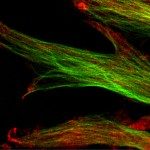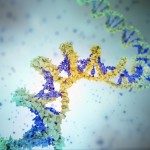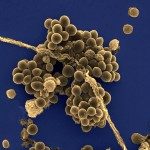Lien vers Pubmed [PMID] – 36951576
Lien DOI – 10.1128/spectrum.05085-22
Microbiol Spectr 2023 Mar; (): e0508522
Streptococcus gallolyticus subsp. gallolyticus (SGG) is an opportunistic gut pathogen associated with colorectal cancer. We previously showed that colonization of the murine colon by SGG in tumoral conditions was strongly enhanced by the production of gallocin A, a two-peptide bacteriocin. Here, we aimed to characterize the mechanisms of its action and resistance. Using a genetic approach, we demonstrated that gallocin A is composed of two peptides, GllA1 and GllA2, which are inactive alone and act together to kill “target” bacteria. We showed that gallocin A can kill phylogenetically close relatives of the pathogen. Importantly, we demonstrated that gallocin A peptides can insert themselves into membranes and permeabilize lipid bilayer vesicles. Next, we showed that the third gene of the gallocin A operon, gip, is necessary and sufficient to confer immunity to gallocin A. Structural modeling of GllA1 and GllA2 mature peptides suggested that both peptides form alpha-helical hairpins stabilized by intramolecular disulfide bridges. The presence of a disulfide bond in GllA1 and GllA2 was confirmed experimentally. Addition of disulfide-reducing agents abrogated gallocin A activity. Likewise, deletion of a gene encoding a surface protein with a thioredoxin-like domain impaired the ability of gallocin A to kill Enterococcus faecalis. Structural modeling of GIP revealed a hairpin-like structure strongly resembling those of the GllA1 and GllA2 mature peptides, suggesting a mechanism of immunity by competition with GllA1/2. Finally, identification of other class IIb bacteriocins exhibiting a similar alpha-helical hairpin fold stabilized with an intramolecular disulfide bridge suggests the existence of a new subclass of class IIb bacteriocins. IMPORTANCE Streptococcus gallolyticus subsp. gallolyticus (SGG), previously named Streptococcus bovis biotype I, is an opportunistic pathogen responsible for invasive infections (septicemia, endocarditis) in elderly people and is often associated with colon tumors. SGG is one of the first bacteria to be associated with the occurrence of colorectal cancer in humans. Previously, we showed that tumor-associated conditions in the colon provide SGG with an ideal environment to proliferate at the expense of phylogenetically and metabolically closely related commensal bacteria such as enterococci (1). SGG takes advantage of CRC-associated conditions to outcompete and substitute commensal members of the gut microbiota using a specific bacteriocin named gallocin, recently renamed gallocin A following the discovery of gallocin D in a peculiar SGG isolate. Here, we showed that gallocin A is a two-peptide bacteriocin and that both GllA1 and GllA2 peptides are required for antimicrobial activity. Gallocin A was shown to permeabilize bacterial membranes and kill phylogenetically closely related bacteria such as most streptococci, lactococci, and enterococci, probably through membrane pore formation. GllA1 and GllA2 secreted peptides are unusually long (42 and 60 amino acids long) and have very few charged amino acids compared to well-known class IIb bacteriocins. In silico modeling revealed that both GllA1 and GllA2 exhibit a similar hairpin-like conformation stabilized by an intramolecular disulfide bond. We also showed that the GIP immunity peptide forms a hairpin-like structure similar to GllA1/GllA2. Thus, we hypothesize that GIP blocks the formation of the GllA1/GllA2 complex by interacting with GllA1 or GllA2. Gallocin A may constitute the first class IIb bacteriocin which displays disulfide bridges important for its structure and activity and might be the founding member of a subtype of class IIb bacteriocins.












